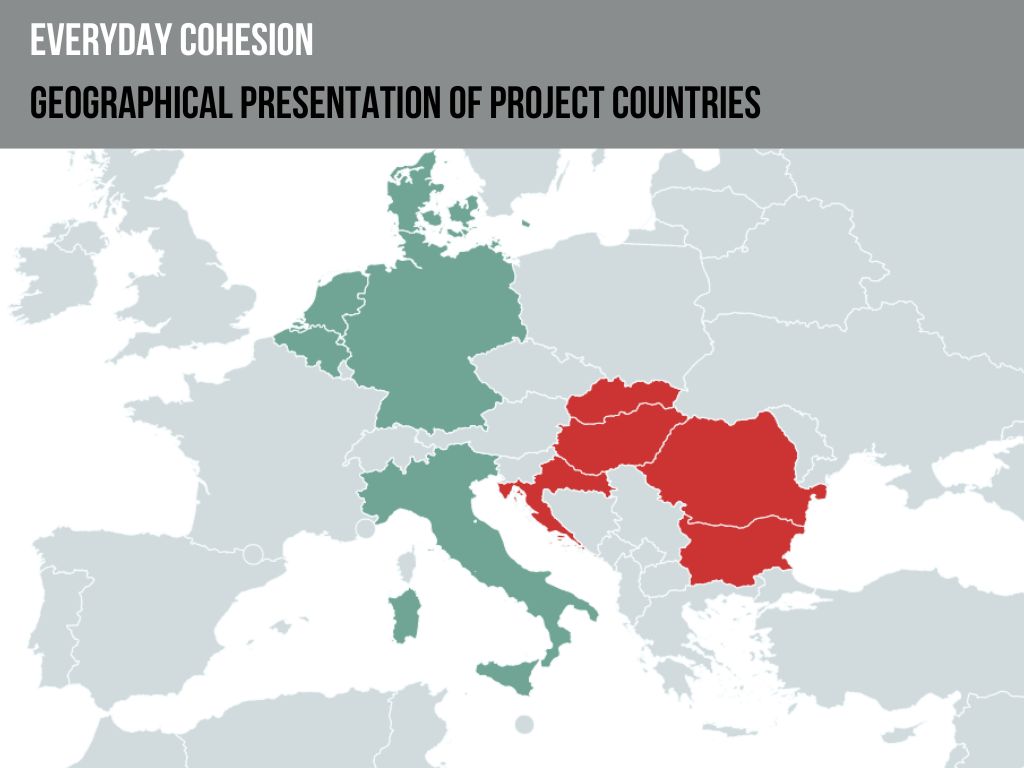Communicating the EU Cohesion policy to citizens
Project background
In a rapidly changing world, under the current uncertain and challenging conditions Cohesion policy is and remains one of the cornerstones of EU policy-making. Its success is key to implement EU’s political priorities especially in the field of a European Green Deal and Digital Europe leading to a smarter and fairer Europe.
From a public perspective Cohesion policy is an area where the EU’s impact on daily life of millions of citizens can be manifested and measured. This is especially true in case of those who live in rural or remote areas.
The 2021-2027 Multiannual Financial Framework brings a new perspective into the Cohesion policy arena with new priorities, targets and set of measures. To make it happen the current project builds on the 9th Cohesion Report prepared by the European Commission and released in March 2024.
Project countries
The project involves nine EU regions, carefully selected based on development categories of the 8th Cohesion Report. Our target group is primarily composed of practising journalists working for local and regional media in 4 net contributing (Denmark, Germany, Italy and the Netherlands) and 5 Cohesion Fund net beneficiary Member States (Bulgaria, Croatia, Hungary, Romania and Slovakia).
| Net contributor Member States | Regions |
|---|---|
| Denmark | Southern Denmark |
| Germany | Mecklenburg-Vorpommern |
| Italy | Sicily |
| The Netherlands | North Holland |

| Net beneficiary Member States | Regions |
|---|---|
| Bulgaria | Ruse |
| Croatia | Baranja |
| Hungary | Közép-Dunántúl |
| Romania | Muntenia |
| Slovakia | Nitra |
During the preparatory process of this project European House made a preliminary investigation in the selected regions of the project countries with the aim to see to what extent Cohesion policy developments are addressed in the local/regional media.
In case of the net contributing Member States the noticeable characteristic feature was the mention of corruption/misuse of funds in the recipient/beneficiary Member States. This phenomenon is considered as a serious stumbling block in the process of overcoming disparities between contributors and beneficiaries.
We also noticed two identical features in the regions of the nine project countries: (1) lack of easy-to-read and use information materials in local and regional media on Cohesion policy issues and (2) complete lack of knowledge of the existence of the Cohesion Report, a flagship document of the Commission relevant to the project.
In case of the beneficiary countries a common characteristic feature was that the European aspect of the Cohesion Funds used was very rarely mentioned; instead, it was put into a national/regional political context emphasising the important role of local decision-makers in securing the applied financial support. Practically no mention was made of the democratic decision-making process, of the “bottom-up” approach voicing citizens’ concerns and proposals leading to a successful broadly based application. Lack of knowledge on the European nature of the Cohesion policy and Funds can easily lead to a reserved attitude or mistrust in the EU institutions generally labelled as the bureaucratic “Brussels”.
Participants
Participants of the project are practising journalists working for local and regional media (printed or digital), media persons, bloggers or vloggers in 4 net contributing (DK, DE, NL and IT) and 5 Cohesion Fund beneficiary countries (BG, HU, HR, RO and SK).
Project activities
Kick-off meeting – Brussels (BE), 17-18 April 2024
Participants: 9 journalists
(1 per country, BG, DK, DE, HR, HU, IT, NL, RO, SK)
Cohesion Field Visit 1 – Hungary – Bulgaria – Croatia – Romania – Slovakia
3-12 September 2024
Participants: 8 journalists from net contributor Member States
(2 per country, DK, DE, NL and IT)
Member State/Region/Places to visit
BG Ruse Ruse & Byala
HR Baranja Osijek/Vukovar & Ernestinovo
HU Közép-Dunántúl Komárom & Nagyigmánd
RO Muntenia Giurgiu & Comana
SK Nitra Komarno & Nové Zámky
Cohesion Field Visit 2
Denmark – Germany – The Netherlands – 8-16 October 2024
Participants: 10 journalists from net beneficiary Member States
(2 per country, BG, HR, HU, RO, SK)
Member State Region Places to visit
DK Southern Denmark Odense & Vissenbjerg
NL North Holland Haarlem & Zandvoort
DE Mecklenburg-Vorpommern Schwerin & Lützow
Cohesion Field Visit 3 – Italy – 27-29 January 2025
Participants: 10 journalists from net beneficiary Member States
(2 per country, BG, HR, HU, RO, SK)
Member State Region Places to visit
IT Sicily Palermo & Villaciambra
What we expect from interested journalists
- participate at the Cohesion field visit(s);
- produce at least 2 articles/videos/radio spots in local/regional media for each visited location.
All justified expenses related to project activities are covered (travel, accommodation, subsistence costs and other related expenses).
About European House Budapest
European House (EH) is a Budapest-based pro-European civil society organisation set up in 1990. Its main objective is to develop active European citizenship and identity based on shared values, foster EU ownership among citizens and promote participatory democracy. EH is an active player on European level: it promotes awareness-raising debates, contributes to EU agenda setting and fosters civic engagement. EH seeks to contribute to the creation of an active, strong, and influential civil society both in HU and Europe using synergies. EH promotes contacts and interactions among CSOs of the four EU macro-regions thereby contributing to shaping and implementing EU macro-regional strategies. A civil pillar of this process is being developed (a proposal for a macro-regional civil strategy) together with the setting up of a network.
